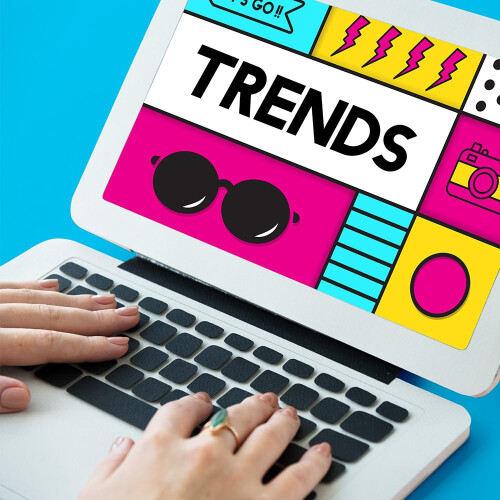
Table of contents
- 1. Dark Design Modes
- 2. 3D Elements and Depth Effects
- 3. Minimalism & Micro-Interactions
- 4. Data Visualization
- What is Data Visualization?
- Why is it so crucial?
- How do designers implement data visualization?
- 5. Content-First Approach
- Why is Content-First important?
- 6. Psychology & Design
- Important design psychology trends include:
- 6. Adaptive Fonts
- What are adaptive fonts?
- Why are they important?
- How do designers implement adaptive fonts?
- 7. Motion and Interactivity
- Conclusion
Web Design Trends 2023 for Websites and Web Applications
14. November 2023
Published in:
WebdesignThe digital universe is constantly on the move. Every year, innovative technologies and creative thinking bring new trends in web design to the fore. Here at mindtwo, we always stay at the forefront of development to provide our clients with the best service. In this article, we take a look at the hottest web design trends for 2023.
1. Dark Design Modes
One of the most striking changes in the world of web design is the rapid rise of dark design modes. They not only look chic but are also easy on the eyes and save energy on AMOLED screens.
Advantages:
- Eye-friendly: Dark modes reduce eye strain, especially in low light.
- Energy-efficient: With OLED and AMOLED screens, a dark design can reduce battery consumption.
2. 3D Elements and Depth Effects
Advancements in web technology now give designers the freedom to experiment with 3D designs. These add an entirely new dimension to websites and applications, offering an immersive experience.
3. Minimalism & Micro-Interactions
Minimalist design is nothing new but remains relevant. In 2023, it's about combining clear, unobtrusive designs with subtle micro-interactions that refine the user experience.
Example: A button that slightly jitters or changes color when hovered over can provide direct feedback to the user.
4. Data Visualization
In today's digital age, data is ubiquitous. Companies collect and analyze a wealth of information to make informed decisions. But what is even more crucial is the ability to communicate this data effectively and make it understandable to the end consumer. This is where data visualization enters the stage – a powerful tool that turns the ocean of data into clear, comprehensible, and often impressive visual representations.
What is Data Visualization?
Data visualization is the presentation of data in a graphical or pictorial form. It allows decision-makers to quickly recognize and understand complex data patterns and trends.
Why is it so crucial?
-
Rapid Information Absorption: In our fast-paced world, users want to absorb information quickly and efficiently. Well-designed charts and graphs can convey a wealth of information in seconds.
-
Better Recall: Visual information is often remembered better than pure textual data.
-
Discovery of Patterns and Trends: By visualizing data, users can identify trends, anomalies, and patterns that would be difficult to discern in a text format.
How do designers implement data visualization?
-
Dynamic Charts: These can update data in real-time, providing the user with an interactive experience. For example, dashboards can show how sales figures are changing live.
-
Interactive Infographics: Users can highlight, filter, or zoom in on specific data points to get exactly the information they need.
-
Narrative Visualizations: Here, a story is told through data, often by combining text and graphics to create a compelling narrative.
-
360-degree Data Views: Advanced technologies now allow for data visualization in a 360-degree environment, which is especially useful for VR (Virtual Reality) and AR (Augmented Reality) applications.
The art of data visualization goes beyond mere charts and graphs. It's about capturing the essence of a data set and presenting it in a form that is both appealing and informative.
5. Content-First Approach
In past years, design often played the starring role on every website, with content taking a backseat. However, by 2023, this trend has reversed. "Content-First" is not just a buzzword but an approach that puts content at the center of every design decision.
Why is Content-First important?
- User-Centered: It's about delivering exactly what users are looking for. A visually impressive website has little value if the content does not meet the user's expectations.
- Search Engine Optimization: Search engines love high-quality content. A Content-First approach ensures SEO is considered from the start.
- Consistency: With a Content-First strategy, it is ensured that design and content go hand in hand and do not work against each other.
The key to the success of this approach is to take content as the starting point and design around it, rather than trying to fit content into a pre-made design. At mindtwo, we place great importance on integrating Content-First principles into our web design projects.
6. Psychology & Design
The design of a website or web application not only affects the user experience but also the psychological response of the user. 2023 shows a stronger fusion of design and psychology.
Important design psychology trends include:
- Color Psychology: Colors elicit emotions and can influence behavior. For example, blue is often associated with trust, while red attracts attention.
- Gestalt Principles: These psychological principles, such as similarity and proximity, influence how we perceive and group visual elements.
- Z- and F-Patterns: Studies show that users scan content in specific patterns. Good web design takes these patterns into account to highlight important content.
- Micro-Moments: These are short, instinctive moments when users decide what to do next. Good design uses these moments to guide the user through the website or application.
The combination of design and psychology allows designers to create web pages and applications that are not only aesthetically pleasing but also functional and psychologically effective. Our experts at mindtwo use these insights to create designs that truly resonate with the user.
6. Adaptive Fonts
In the ever-evolving world of web design, typography plays a crucial role. While fixed font sizes and styles might have been sufficient in the past, today's variety of devices and screen sizes demand a more dynamic approach. This is where the importance of adaptive fonts comes into play.
What are adaptive fonts?
Adaptive fonts, also known as "responsive typography," are font systems that change according to the specific needs and characteristics of the display device. This can mean that the font size, line spacing, or even the font style changes depending on the screen size, resolution, and orientation.
Why are they important?
-
Versatility: With the growing diversity of devices, from smartphones to tablets to desktops and even large screens, typography must be flexible enough to be clear and understandable on all.
-
User Experience (UX): A good text flow that adapts to the device makes reading and understanding easier. This can significantly enhance the overall quality of the user experience.
-
Design Coherence: A consistent appearance across different platforms and devices strengthens brand identity and perception.
How do designers implement adaptive fonts?
-
Fluid Typography: Using relative units like "vw" (Viewport-Width) can dynamically scale font sizes based on the width of the viewport.
-
Media Queries: They allow designers to define specific typographic styles for different screen sizes.
-
Variable Fonts: A newer technology that allows designers to use different styles and weights of a font from a single font file, increasing flexibility and adaptability.
The future of web design is dynamic, and adaptive fonts are a key element in meeting this dynamism. At mindtwo, we recognize the importance of typography in the digital landscape and skillfully use it to create clear, effective, and engaging designs.
7. Motion and Interactivity
In today's digital landscape, users are not just looking for information but for an experience. A lively and interactive web design can deliver just that. Motion and interactivity are at the heart of this trend as they transform a webpage or app from a passive source of information into a dynamic and captivating medium.
Animations: These are much more than pretty decorations. They can:
- Enhance narrative: Animations can tell a story or convey a message by bringing motion and life to the content.
- Guide users: They can gently lead the user by directing their attention to key elements or helping them navigate through an application.
- Provide feedback: For example, a button can be animated when clicked to show the user that their action has been recognized.
Parallax Scrolling: This technique, where the background of a webpage moves slower than the foreground, creates a sense of depth and space. It conveys:
- Immersion: The feeling of "diving into" the website turns the visit into a visual experience.
- Dynamism: The movement generates kinetic energy that makes the content exciting and lively.
Interactive Elements: They transform passive viewers into active participants. These include:
- Hover Effects: When an element changes or animates as soon as the user hovers over it.
- Interactive Infographics: Here, the user can play with the data and visualize it in different ways.
- Gamified Elements: These use game-based mechanics to encourage engagement and interaction.
In summary, motion and interactivity can greatly enhance a user's engagement, dwell time, and overall experience on a website or app. In a time when user experience is paramount, designers should not underestimate the power of these elements.
Conclusion
2023 is all about the combination of aesthetics and functionality. These trends show how important it is to always provide innovative and user-friendly web designs. At mindtwo, we are proud to be at the forefront of these developments. If you want to learn more about our web design expertise or are ready to design your own website or web application, contact us. We are here to help.
Can we help?
You have an exciting project and want to work with us? Contact us now!

